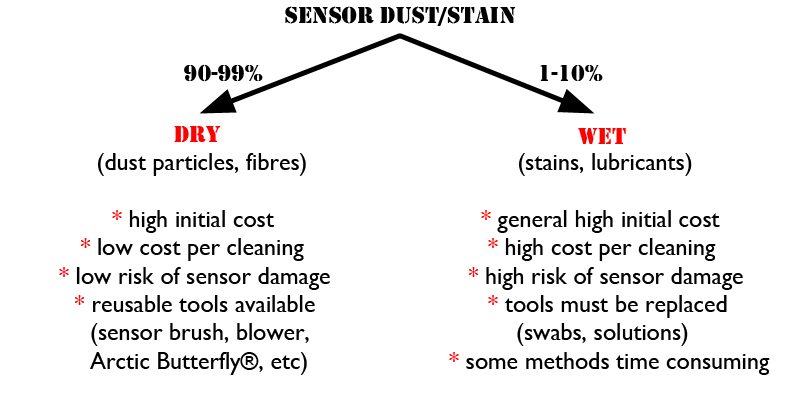


The percentages in this diagram represent the 'normal' frequency of the type of cleaning needed to remove debris that is found on a contaminated sensor. Many factors will skew these numbers depending on the environment and the care taken while using and storing the camera. Humidity, aridity, temperature, frequency of lens changes, diligence while changing lens, and various other considerations will affect the type of contamination and the type of cleaning necessary. For example, one should expect to experience an increase in dry contaminants and dry method cleaning while in arid conditions such as the desert while on the other hand, they should expect an increase in problems arising from moisture in humid conditions such as the rainforests of South America. Precautions should be taken to ensure that one has the proper tools for the proper environmental conditions and that you are not putting your sensor at unnecessary risk by employing the wrong method to clean the debris.
As more and more people, professional and amateur alike, adopt using digital SLR cameras for their work and pleasure, a niche market has opened for individuals and companies to develop specialized tools, liquids, and methods on how to clean the digital sensor and chamber area. This new line of products, and its methods, range from those that are crafted by the camera owner itself to proprietary patented technology that at first may seem expensive, but, depending on your demands, may save you a small fortune (and a great amount of stress) in the end. Here are some of the main products and devices that are being utilized today.
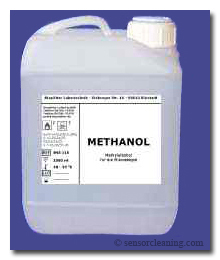

Any products that use a methanol base are not recommended to be used within the compartment of the camera housing. Methanol is a highly corrosive solvent that deteriorates plastic, rubber, aluminum and some other metals. This creates a potential for pentrating the seal between the low pass filter and the sensor itself, allowing debris to truely contaminate the sensor. If used on the chamber wall of the camera, the glue that holds the fabric in place may dissolve, leaving the fabric hanging loosely. Methanol is highly flammable, in both liquid and vapour states, and is used in pure form as racing car fuel or as an alternative fuel source (85:15 methanol:gasoline) in specially developed cars (Flexible Fuel Vehicles). It is highly toxic in relative small doses (30ml -240ml) and can lead to blindness in smaller amounts. It is readily absorbed through the skin as a liquid or inhaled as a varpour and is harmful in prolonged exposure. The purity of methanol is relative to storage as it is hygroscopic (absorbs moisture) and will be diluted by drawing moisture from the air if improperly sealed. The hygroscopic property of methanol may draw the microscopic water molecules from the sensor filter, increasing the static charge across the filter and raising the potential for dust attraction. Methanol, because it is a solvent, may break down any glue that is holding together a swab, leaving trace amounts of the adhesive behind as the methanol evaporates. Precautions should be heeded when traveling by air as methanol is classified as a hazardous material and is not allowed on airplanes. You could be subject to expensive fines, receive a criminal record, serve time in prison, and be added to the infamous ‘no fly list.’
Some solutions, most notably methanol, are available on the market in greater quantity for less money as compared to their smaller counterparts. Although purchasing in large quantities may seem beneficial, there are consequences to this action. Large quantities require proper storage containers and facilities so that contamination and leakage do not occur. Over time some solutions may loose their purity due to the hygroscopic nature of alcohol based products.
| Advantages | Disadvantages |
| • Low cost | • Very toxic |
| • Not regulated (like ethanol: need license) | • Very flammable |
| • Strong solvent; strong cleaning power | • Travel restrictions (air) |
| • Dries quickly | • Corrosive on most internal camera (chamber) parts except glass |
| • Hygroscopic (absorbs moisture from atmosphere) | |
| • Builds static charge, leading to more dust attraction | |
| • Should not be used as 1st line of cleaning esp. dry particles ( chance of dragging and scratching if dragging dry sharp particles) |
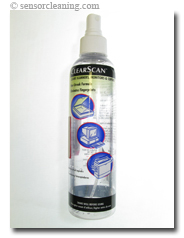
Brand name and specialized glass cleaners are not recommended because they may leave behind an oily residue, trace amounts of organic material on the sensor filter or embed scratches into the sensor filter due to micro-abrasives. Glass cleaners of this nature are basically filtered water, isopropyl alcohol (or vinegar, ammonia), and colouring dye, as well as some specialized chemicals which vary product to product. The filtration process of the water does not get out all organic impurities and will leave a residue on the sensor. Also the dye itself will be left behind after the other constituents have evaporated.
| Advantages | Disadvantages |
| • None | • Extreme pH levels (acid or a base) |
| • May contain unknown chemicals harmful to filter coating | |
| • Leaves streaks |

Brand name contact lens solutions are not recommended because they contain any number of preservatives, salt (saline), and proteolytic enzymes that leave residue on the sensor filter or may inlay scratches.
| Advantages | Disadvantages |
| • None | • May contain salt (saline) |
| • May contain preservatives that filter light | |
| • May contain enzymes that coat IR filter after evaporation |

Water is a solvent but a fairly weak one. It does not remove oily substances very well as they are hydrophobic. Also, unless it is very refined, it will leave behind a residue from the organic compounds found in impure water.
| Advantages | Disadvantages |
| • Readily available in pure form | • Not a good cleaning agent |
| • May contain harmful impurities | |
| • May contain quartz, silica sand that is harmful to the sensor filter and may cause a severe scratch |
Breathing onto the sensor and then trying to wipe it clean with a swab will not produce a desired effect. Proteins, starch, and bacteria commonly found in saliva will be placed on the sensor and are difficult to remove, even when using a strong solvent.
| Advantages | Disadvantages |
| • Readily available | • Hard to do without getting spittle on filter |
| • Contaminants (bacteria, protein, starch, etc) in breath very hard to remove | |
| • Requires vigorous cleaning if spittle encountered; higher risk of sensor damage; |
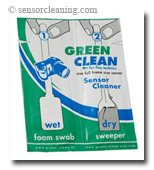
The Green Clean swabs are contructed of a foam and unfortunately, the wet swabs are oversaturated which may lead to an abundance of liquid in and around the sensor filter with a potential of penetrating the seal. Due to their construction, the swabs have difficulty reaching the corners of the sensor and, after using the dry swab, may still leave behind excess liquid and not completely clean the sensor.
| Advantages | Disadvantages |
| • Travel friendly | • Expensive |
| • No extra liquid needed | • Bulky and awkward |
| • Wet swabs tend to be oversaturated | |
| • Swab design makes it hard to reach corners properly |
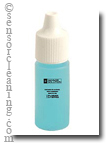
Delkin's SensorSolution is a specially formulated liquid that comes with the DigitalDuster cleaning kit. It claims to not leave any residue, though it contains a coloring dye that when placed on the IR filter may prevent certain frequencies of light to pass through properly.
| Advantages | Disadvantages |
| • Not sold individually | |
| • Color dye not desirable (may leave film) | |
| • May leave streaks | |
| • May not remove stains or smears effectively |
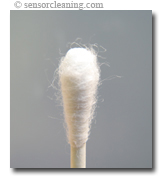
There is an assorted array of swabs on the market that are used for diverse applications. It is recommended that, when shopping for swabs to clean your camera, you get the right ones. Regular cotton are strongly not recommended. Cotton swabs fray and will deposit fibers on the sensor or may snag in the corners. They also use adhesive to prevent the shaft from poking through the cotton and also to bind the cotton to the shaft. Most types of cotton contain a fatty acids which may leech onto the sensor when introduced to a strong solvent. It is important that the right type of swab is used with the right type of liquid, as some liquids may cause the swab to break down and leave residue behind. For example, as mentioned earlier, methanol will break down the adhesive of some swabs and leave it behind on your sensor after the methanol evaporates. Also, average cotton swabs have a coating agent that is composed of a cellulose polymer agent that can be broken down and left behind.
| Advantages | Disadvantages |
| • Readily available | • Fibres may snag and contaminate camera |
| • Low cost | • Adhesive used in construction may be dissolved by strong solvents and contaminate IR filter |
| • Absorbent to liquids | • May have starch powder |
| • Shaft may poke through once adhesive shield has been dissolved by solvent |
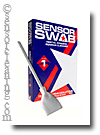
Photographic Solutions has been providing photographic cleaning solutions for quite some time and were the forerunner in developing cleaning products for digital cameras.
| Advantages | Disadvantages |
| • Fits most sensor sizes | • Expensive compared to alternatives |
| • Streak free | • Manufacturer recommends that swabs be used with Eclipse® or E2™ (methanol based solutions) |
| • Works with other manufacturers cleaning solutions | |
| • Popular within the professional digital photography community |
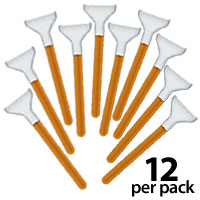
VisibleDust Sensor Cleaning Swabs™ are specifically tailored to fit the dimensions of your particular sensor size, enabling it to effectively clean the sensor without leaving any streaks, scratches or pooling any liquid. The soft fabric is designed to clean delicate surfaces and has been used to clean the sensitive optics of Deep Space Telescopes. This particular fabric is not recommended to be used with water based sensor cleaning solutions. DHAP Sensor Cleaning Swab™(s) come in three sizes to fit your particular sensor: 1.0x (full frame), 1.3x and 1.5x-1.6x.
| Advantages | Disadvantages |
| • Cheaper than alternatives | • Should not be used with water based solutions |
| • Cleans edge to edge | |
| • Streak free | |
| • Perforations to deter liquid pooling (patent pending) | |
| • Works with other manufacturers cleaning solutions such as E2 and Eclipse | |
| • Fits most sensor sizes | |
| • Popular within the professional digital photography community with rave reviews |
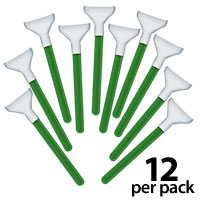
VisibleDust Sensor Cleaning Swabs™ are specifically tailored to fit the dimensions of your particular sensor size, enabling it to effectively clean the sensor without leaving any streaks, scratches or pooling any liquid. The special multi-fabric design is constructed to work with most sensor cleaning solutions on the market. DMX-100 Sensor Cleaning Swab™(s) come in three sizes to fit your particular sensor: 1.0x (full frame), 1.3x and 1.5x-1.6x.
| Advantages | Disadvantages |
| • Cheaper than alternatives | |
| • Cleans edge to edge | |
| • Streak free | |
| • Perforations to deter liquid pooling (patent pending) | |
| • Works with other manufacturers cleaning solutions such as E2 and Eclipse | |
| • Fits most sensor sizes | |
| • Popular within the professional digital photography community with rave reviews |
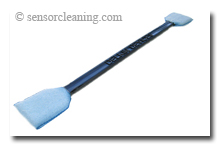
Delkin SensorWand type swabs come with their SensorScope System, DigitalDuster Kit, or DigitalDuster Refill package. They unfortunately cannot be bought seperately. The manufacturer states that the swabs are constructed with a 'lint free' and 'non abrasive' fabric with perforations in the wand head to reduce oversaturation. Each individual SensorWand comes with a swab on each end of the shaft and is promoted as a wet/dry swab, indicating that one end is to be used with their SensorSolution and the other is to dry the IR filter off. This construction is unsuitable because one has to be very careful not to contaminate the top end of the swab while cleaning with the bottom and trying to get proper leverage. The swab design itself is unfortunate as well because the seam is very prominent and may damage the IR filter.
| Advantages | Disadvantages |
| • None | • Prominent seam that may scratch IR filter |
| • Dual head swab may lead to contamination due to incovenient design | |
| • Not sold individually | |
| • Expensive | |
| • Inferior quality compared to competitors |

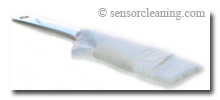
When sensor cleaning first started to become a problem for photographers and there was no products on the market that allowed them the convenience of quickly cleaning the IR filter, there was only two options: either send the camera into the shop and get it cleaned or make your own tools and clean it yourself. For professional photographers, waiting up to 3 weeks for their 'bread and butter' just would not do. Also there was (and still isn't) a guarantee that the sensor will be totally clean. Taking matters into their own hands, various methods were tried to varying success. One method, generally known as the 'Copperhill Method,' was posted on the internet and became popular. The ingredients for this method are a spatula, side cutters, PecPads, tape, methanol, patience and a little elbow grease. First the individual has to cut the spatula to the appropriate size (of the sensor), followed by cutting the tip into a wedge. Next the individual has to wrap a PecPad around the spatula in a particular way, making sure that they do not contaminate the pad with the oils from their fingers. Then the individual adds a few drops of methanol to the pad and cleans the sensor.
| Advantages | Disadvantages |
| • Inexpensive | • Tedious and time consuming |
| • Can be used with any manufacturers cleaning solutions | • 'Recommended' to be used with methanol |
| • More convenient products on the market today | |
| • Impractical for use in the field | |
| • Risk of contamination during construction |
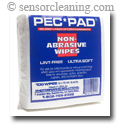
As mentioned in the 'Generic Wands' section, PecPads® have been the choice of photographers in creating their homemade devices for cleaning the camera sensor. This is against the manufacturers recommendation, stating that they do not approve of using the PecPads on the CCD (and by association the CMOS). They are recommended for use on a myriad of other sensitive surfaces but not the IR filter itself.
| Advantages | Disadvantages |
| • Popular within the professional digital photography community | • Manufacturer does not recommend usage for sensor cleaning |
| • Low cost |

VisibleDust VDust Plus™ cleaning solution offers a twofold cleaning combination in that it cleans both oil and water based stains from your sensor. The manufacturer states that the special multi-ingredient formula helps cut down on friction and static build up while providing a safe and smooth cleaning process. For travelling photographers, you'll be happy to find that it is completely safe for air flight travel. VisibleDust Orange DHAP swabs are tailored to the viscosity of this product but VDust Plus™ can be used with other swabs.
| Advantages | Disadvantages |
| • Cleans both oil & water based stains | • Not suitable for 'tough' oil stains |
| • Travel friendly (air) | • Less toxic than methanol based products |
| • Popular within the professional digital photography community with rave reviews |

VisibleDust Chamber Clean™ is not directly for cleaning your sensor but it does provide an advantage that will keep you sensor cleaner over the long term. It is designed to clean the inner chamber of your camera so that dust, lubricants and other contaminants are reduced to a minimum while not harming the chamber wall. It also provides an anti-static barrier to prevent further dust from settling. Special care must be taken to not contaminate the sensor filter or mirror while cleaning with this product or you may very well end up in a worse state than you began with. This product is travel friendly.
| Advantages | Disadvantages |
| • Helps reduce future sensor dust | • Must be careful not to disturb the IR filter or mirror |
| • Travel safe (air) | |
| • Dust repellent anti-static barrier | |
| • Popular within the professional digital photography community with rave reviews |

VisibleDust Sensor Clean™ is a specially developed solution to clean the IR filter of water based stains. Unfortunately it does not clean any stains that have been produced by oil/lubricant contamination or the smears that may be experienced after contamination. It offers an anti-fogging and anti-static barrier to prolong the cleanliness of your IR filter by acting as a dust repellent. VisibleDust Green Ultra MXD-100 swabs are tailored to the viscosity of this product but Sensor Clean™ can be used with other swabs. It is non-toxic and travel friendly.
| Advantages | Disadvantages |
| • Developed especially for water based stains | • Does not clean oil/lubricant based stains very well |
| • Non-toxic | |
| • Dust repellent anti-static barrier | |
| • Anti-fog properties; excellent in humid conditions (beach, skiing, etc) | |
| • Travel safe (air) | |
| • Popular within the professional digital photography community with rave reviews |

VisibleDust Smear Away™ is formulated to clean the tough stains that occur when spittle (it happens), oil, and any other type of lubricants gets onto the sensor filter. Sometimes it is not known at the time what kind of stain is on the IR filter and a 'normal' cleaning will produce an adverse effect: a smear. Smear Away™ is a good answer to this problem. VisibleDust Green Ultra MXD-100 swabs are tailored to the viscosity of this product but Sensor Clean™ can be used with other swabs. Smear Away™ is a non-methanol based cleaner so it is travel friendly.
| Advantages | Disadvantages |
| • Popular within the professional digital photography community with rave reviews | • While it cleans 'tough' stains/smears effectively, it may leave streaks that may need to be removed by another more sensitive cleaner |
| • Travel safe (air) | |
| • Dust repellent | |
| • Provides buffer while cleaning to prevent hard dust from scratching IR filter | |
| • Excellent cleaning power |
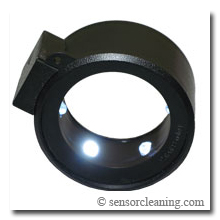
The Sensor Loupe™ from VisibleDust with its BriteVue XL technology is an excellent tool in the fight against sensor contamination. Many factors contribute to this being an invaluable piece of hardware in any photographers arsenal. The array of six vivid LEDs provide excellent lighting that highlight any debris on the sensor and within the chamber. The high quality K9 optical glass lenses, with 5x magnification, provide a clear high resolution view. A coating of MgF2 on the lenses provides a dual purpose of sealing the lenses from any mildew build up and also reduces chromatic aberrations. The light weight and convenient ease of use enable the Sensor Loupe to easily inspect the chamber area of any DSLR.
| Advantages | Disadvantages |
| • Convenient; Portable | • None |
| • Vivid LED array | |
| • Crystal clear K9 optical glass lenses with MgF2 coating | |
| • Easily inspect any DSLR chamber, examine negatives, etc |
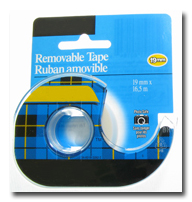
This section covers a myriad of products whether it be old fashioned tape or some newly introduced technology. Basically the premise for these products is the same: a medium with an adhesive property is pressed onto the sensor to pick up any debris. Many things are wrong with this theory. For one, most of these products need more than one 'pressing' to cover the entire surface area of the sensor, leading to transfer of the debris from one area to another if you are using the same tool. This can be very dangerous if a hard substance is on the sensor filter, such as a grain of sand, and is crushed into the filter. Secondly, the adhesive property may bind to the sensor and, depending on how tacky it is, may very well damage your sensor by pulling on it in an unusal manner. For example, many sensors today are fitted with highly sensitive anti-shake gyroscopes, and anti-dust piezoelectric mechanisms that could be thrown out of calibration. Also it may tear the filter away from the O-ring seal that provides a barrier and protects the sensor. Varying temperatures can affect the viscidity of the adhesive component and may bond to the sensor more readily under colder conditions while it may leave adhesive residue behind under warmer conditions. Thirdly, it does not remove any spots, stains or smears that may have appeared due to moisture or lubricant and will transfer them to another area of the filter. Fourthly, it does not remove the dust spots that firmly attach themselves to the sensor filter when moisture is present and than evaporates.
| Advantages | Disadvantages |
| • Travel friendly | • Long term effect unknown |
| • Easy to apply | • Not for stain removal |
| • Pulling on sensitive mechanisms (gyros/piezoelectric filter) may cause damage | |
| • Various temperatures may produce varying (unwanted) effects |
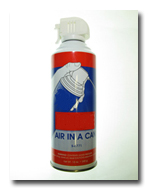

Using canned air to clean the sensor is a particularly dangerous idea. The shear force from the air pressure could seriously damage the mechanisms with the camera housing. The propellant can condense on the surface of the camera, leaving liquid and residue. Also if the can is used upside-down does not allow the liquid fluorocarbon to immediately vapourize, turning the output into a freeze spray. This again could seriously damage the sensitive mechanisms with the housing of the camera.
| Advantages | Disadvantages |
| • Easily available in most countries | • Not travel friendly (air) |
| • Low cost | • May produce liquid or 'freezing' on the sensor |
| • Do not remove stains | |
| • Produces a 'violent' air stream that may damage delicate components |
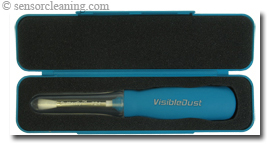
The VisibleDust Arctic Butterfly® (patent pending) is a unique spin (pun intended) on the methods employed to remove dry debris from the IR filter. It is constructed of a handle with an embedded battery case and motor, and a brush with 'Super Charged Fibers.' When the Arctic Butterfly® is turned on, it spins the brush rapidly producing two desired effects: a) cleaning the brush of any dry contaminants and b) charging the bristles. The bristles are the reverse polarity of dust, which naturally draws the dust away from the sensor to the brush leaving the IR filter clean. It seems expensive at first compared to the other alternatives, but in the long run it will probably save you a small fortune due to the fact that it can be reused over and over again.
| Advantages | Disadvantages |
| • Removes dry debris very effectively | • Initial cost above average |
| • Travel friendly (air) | • Care must be observed not to create smears with oil/water contaminants |
| • Easily cleaned and recharged | |
| • Low cost per cleaning over long term | |
| • Utilizes 'Super Charged Fiber' technology | |
| • Popular within the professional digital photography community with rave reviews |

The LensPen SensorKlear uses a carbon-based compound on the tip that is used to expunge the debris on the sensor. This compound is left behind in trace amounts of residue and will reduce the image quality. Also, it is constructed to pick arbitrary dust specks, but usually these dust specks are not visible to the human eye, which is why we advocate full pass cleaning methods. The manufacturer suggests that the tips can be used up to 50 times each and recommends cleaning the tip with a chamois or soft cloth after use. We find this idea not beneficial, because it not only removes the debris but also removes the compound used to clean. Also it may draw debris from the cloth and deposit it on the sensor when used next.
| Advantages | Disadvantages |
| • Low initial cost | • Need 'dust map'; hard to know exactly where dust is on a sensor |
| • Carbon based tips produce residue | |
| • Tips need to be replaced | |
| • Potential for dust transfer when cleaning tip |
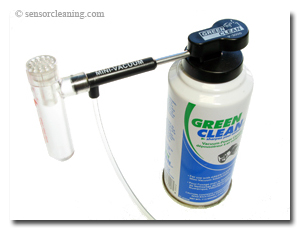

The Green Clean vacuum based cleaning method uses a can of compressed air to create the vacuum. The suction created by the vacuum may stir the air current within the camera chamber, shifting the dust and making it airborne, which may eventually settle on the sensor. Also the vacuum action may produce air friction which builds a static charge across the sensor, making it more attractive to dust. Air travels places restrictions on compressed air so it is not travel friendly, and is not readily available in all countries.
| Advantages | Disadvantages |
| • Removes debris surrounding sensor | • Not used directly on IR filter; hard to not contact IR filter |
| • Helps sensor cleanliness duration by cleaning chamber area | • Potential for damaging the IR filter |
| • Not travel friendly (air) | |
| • Vacuum action may stir more dust onto sensor |
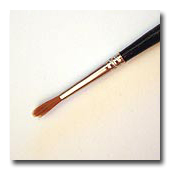
Any off the shelf cosmetic brush or artist brush is not recommended to use in cleaning the sensor of a digital SLR camera. Due to the popularity of the VisibleDust Sensor Brush™, several replica brush have come on to the market. These 'average' brushes are made of low-quality nylons and the cleaning action relies on sweeping the dust across your filter like gravel across a floor. It has been noted that, after continual use, these brushes will leave microscopic marks on your filter, eventually degrading your image quality. There have been many brushes designated for digital SLR sensor cleaning, but few have proven to be anything more than a typical brush with a fancy name.
| Advantages | Disadvantages |
| • Inexpensive | • Fibers not constructed for sensitive cleaning purposes; may leave marks on IR filter |
| • Readily available | • Oils, adhesives, and other contaminants may be embedded within the bristles of these products and contaminate the IR filter |
| • No quality control; untested | |
| • Most are cleaning by sweeping dust across IR filter, not pulling it away |
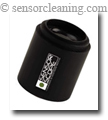
Delkin SensorScope is a new device on the market for the war on dust on the digital SLR sensor. It is formatted to fit onto the lens mount and produces a 5x magnified view of your sensor for examination, with the aid of 4 built-in LED lights. It is not necessarily for cleaning, but rather is to be used to see whether or not you should clean you lens. It comes in a package with the SensorVac, SensorWands, and SensorSolution for US$189.99. The Sensorscope is reminiscient of a loupe and seems relatively high priced considering the quality of the other materials included in the package. It has also been noticed that although the manufacturer intimates that the SensorScope was customized to fit all Canon and Nikon cameras, and should fit most other digital SLR cameras, this not the case in our trials (did not fit Canon 5D, 1Ds, etc).
| Advantages | Disadvantages |
| • Helps detect dust on sensor | • Overpriced; |
| • Not sold seperately; bundled with inferior products | |
| • Other magnifiers (loupe) available | |
| • Does not fit all digital SLR (even Canon or Nikon as advertized) | • Only helps locate dust, does not remove it |

The Delkin SensorVac is a battery/USB powered vacuum that is advertized by the manufacturer as a customized mini vacuum to clean the sensor with a unique static free brush. The design of the vacuum is similar to that of the US$7-15 USB keyboard vacuums on the market today and the bristles on the brush seem coarse to be applied to anything as sensitive as the IR filter on a digital SLR camera. The SensorVac is not sold seperately, and is sold in the SensorScope or DigitalDusting kits which are overpriced and contain inadequate products.
| Advantages | Disadvantages |
| • Coarse bristles may damage the sensor filter | |
| • Off the shelf USB keyboard vacuum (US$7-15) not designed for cleaning the IR filter | |
| • Expensive |
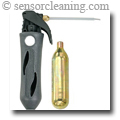

Any 'brand name'/generic CO2 cartridge air blower should not be used to blow dust off of the sensor filter. The air stream that is produced by these devices is too strong and has a high potential for damaging the sensitive components housed within the chamber area. Even if great care is taken to throttle the air flow, there is no assurance that all the dust will be removed as it may fall back onto the sensor after being stirred about. This type of air blower is incapable of removing any stains that may have formed on the IR filter and because it is a compressed gas, the CO2 cartridges are not travel friendly.
| Advantages | Disadvantages |
| • Inexpensive | • Air current too forceful; high potential for sensitive mechanism damage (gyros, shutter, etc) |
| • Low risk of liquid discharge | • Not travel friendly (air) |
| • May not completely remove all debris | |
| • Will not remove any stains |

Use of the blower bulb to clean the IR filter is one of the few (if not the only) manufacturer recommended methods, aside from sending it back to the manufacturer for a cleaning by their tech services. This is due not to its effectiveness but more so its relative safety in use. It is not as efficient as other methods because it disperses the dust instead of completely removing it, leaving potential for the debris to fall back onto the sensor filter. It also, like other air blower methods, is unable to remove oil/water stains.
| Advantages | Disadvantages |
| • Low cost | • Disperses dust, does not remove it |
| • Safe | • Not as effective as other methods |
| • Recommended by most camera manufacturers because of its relative safeness (not effectiveness) | • Does not remove oil/water stains, smears |

Photographic Solutions BrushOff(tm) sensor filter cleaning brush is a device that is, by reports of the manufacturer, developed in conjuction with NASA (a search on the NASA website did not turn up anything). The basis for the technology behind the BrushOff(tm) is that it neutralizes both the dust particles (which are negatively charged) and the sensor (which is positively charged), leaving the dust free to be removed. This has the effect of 'freeing' the dust from the sensor to be swept across the sensor, which is not desirable as harder particles will tend to scratch the IR filter. Photographic Solutions seems to contradict themselves in explaining how they remove the dust because first they say that they neutaralize the dust and sensor, and then go on to say that the special filaments act as a '"vacuum" to pick up negatively charged dust from the positively charged sensor.' To clean the brush it is recommended by the manufacturer to purchase their Eclipse solution and PecPads to clean the bristles which seems odd considering blowing the dust out may be more practical. The grounding plug is a none issue, and will not be discussed.
| Advantages | Disadvantages |
| • Portable | • Not effective |
| • Awkward (with the grounding wire) | |
| • Recommended cleaning seems irregular |
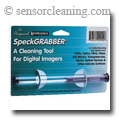
The Kinetronics SpeckGRABBER(tm) is a device that has been created to individually remove contaminants from fragile surfaces. With its low initial cost, it seems like an atractive alternative to the somewhat pricey alternatives. Unfortunately it requires prior knowledge of exactly where the dust is located on the sensor, and the dust that effects digital sensors may be hard or impossible to see with the naked eye. Because it uses an adhesive to pick up the particles from the sensor filter, it has the potential of leaving residue behind. The SpeckGRABBER may well be suited for larger dust particles that are obvious, but it unsuitable for use on small particles and incompatible for cleaning stains.
| Advantages | Disadvantages |
| • Low initial cost | • Impossible to visually see all debris on sensor |
| • Easy concept of use | • May leave residue |
| • Tips needs to be repeatedly cleaned before use |

VisibleDust was the first to come out with the Sensor Brush(tm) which is an innovative technology that provides a simple and impressive way to clean the sensor filter free of dust. The brushes were developed out of a technology in a laboratory to clean microscopic slides without scratching them. The special filaments that the brush is constructed of help them hold a positive charge that does not dissipate on contact with opposite charges. The 'Super Charged Fiber' technology is the process that enhances the charges on the fibers as compared to regular brushes. This enables them to attract the dust away from the sensor filter to the brush, leaving your filter clean. This method is great for cleaning dust but will not work on stains and may create a smear if passed across a stain. The first generation of these brushes used a can of air to clean and recharge the bristles.
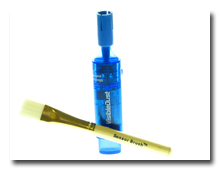
After finding complications with flying with canned air, VisibleDust created what has now come to be known as the 'spinning device' that spins the brush so that the bristles are cleaned and charged by centrifugal force. This was the precursor to their now popular Arctic Butterfly®, which is a built-in spinning device brush combo.
| Advantages | Disadvantages |
| • Ease of use | • First generation needed canned air; Not travel friendly (air) |
| • Effective for debris removal | • High initial cost |
| • Innovative technology (patent pending) | • May create smears if stains are apparent |
| • Popular within the professional digital photography community due to positive peer reviews | |
| • Utilizes 'Super Charged Fiber' technology | |
| • Low cost per cleaning over long term |
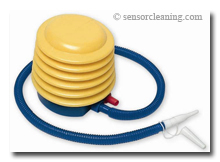
Using a foot pump, such as those used to used to inflate air mattresses, to blow off the sensor is not recommended as it awkward to use, may be too forceful of a air current and damage some of the camera components. Also, because it is located on the ground and draws in air, it may introduce more dirt into the chamber air.
| Advantages | Disadvantages |
| • Low cost | • Bulky and awkward to use |
| • May produce to forceful of an air stream | |
| • Particle may be uptaken into pump and bombarded onto sensor filter |
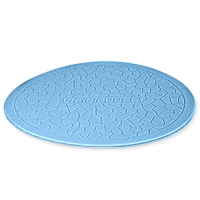
Dust Snapper™ provides Ultra-Clean surface for critical cleaning™. Using ionic and enhanced magnetic action of Dust Snapper™ ,one can provide an Ultra-clean camera/lense environment.The combined ionic and magnetic action of Dust Snapper™ removes and locks the dust particles from contact area of camera or lens.
| Advantages | Disadvantages |
| • The combined ionic and magnetic action of Dust Snapper™ removes and locks the dust particles from contact area of camera or lens. | |